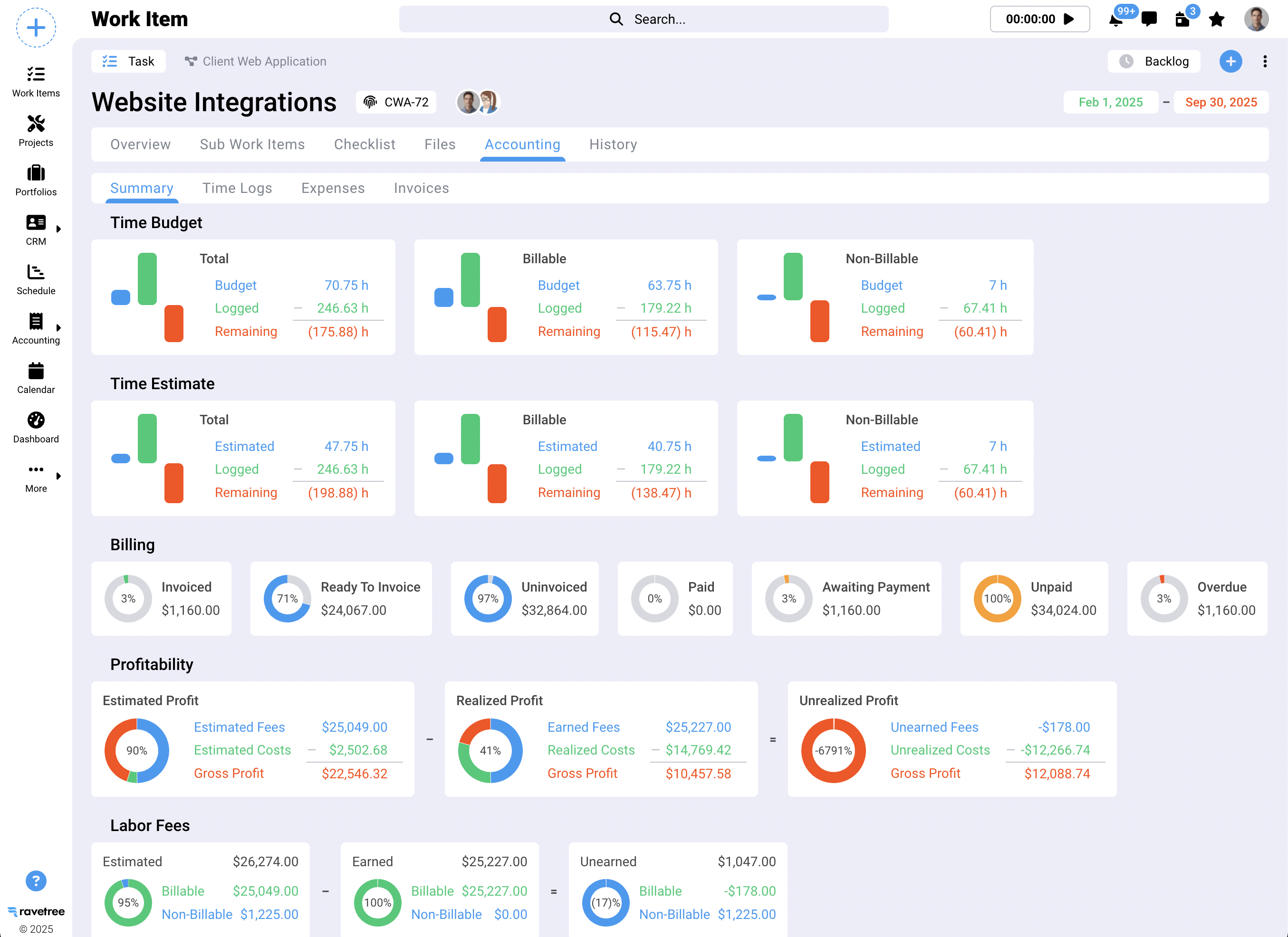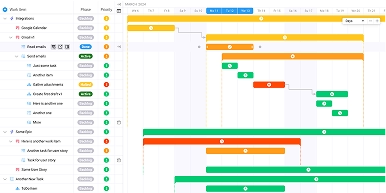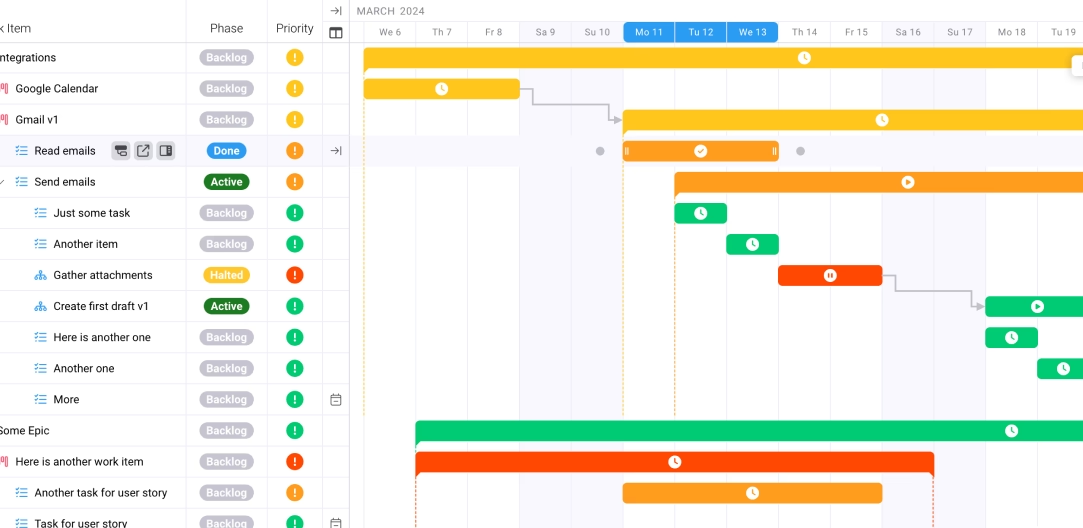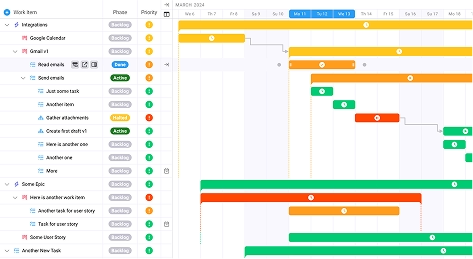
Ravetree vs. Asana: Which Is The Best Tool For Agencies?
Key takeaways:
Choosing between Ravetree vs. Asana isn't just about features—it's about finding a platform that can transform your agency's operations from chaotic to controlled. While 47% of projects are run by certified project management professionals, the tools they use vary dramatically in their ability to support agency-specific workflows. The right choice between Ravetree vs. Asana could be the difference between profitable growth and operational bottlenecks.
The Real Cost of Choosing the Wrong Project Management Platform
Most agencies don't realize they have a tool problem until it's too late. You've probably experienced the symptoms: duplicate work across platforms, projects bleeding over budget, 70% of agencies cite new business sales as their main challenge, yet they're stuck managing with tools designed for internal teams, not client service businesses.
The wrong project management software creates cascading problems. Your team logs time in one system, tracks budgets in another, and communicates in a third. Meanwhile, you're manually pulling reports together while your competitors are making real-time decisions with integrated data.
Here's what agencies fail to consider: generic task managers like Asana were built for product teams coordinating internal work. They excel at helping software companies ship features. But agencies need something fundamentally different—platforms that connect project management directly to billing, profitability tracking, and CRM functionality.
Why Traditional Project Management Tools Fall Short for Agencies
Underestimating scope and lacking resources are major obstacles to timely project completion for agencies of all sizes. Yet most project management platforms treat these as separate problems requiring separate solutions.
Consider the typical agency workflow: A prospect becomes a client. That client needs a proposal. The proposal becomes a project. The project requires resources. Those resources log time. That time gets billed. The billing impacts profitability. Every step generates data that should inform the next decision.
Traditional tools fragment this workflow. Asana handles tasks beautifully but leaves you cobbling together separate systems for time tracking, resource planning, and financial management. You end up with data silos that prevent you from answering the most important question: "Are we actually profitable on this project?"
Agency competition and burnout are significant problems in 2024, driven largely by operational inefficiencies that prevent teams from focusing on billable work. When project managers spend hours each week manually updating spreadsheets and consolidating reports from multiple systems, that's time not spent delivering client value.
The Financial Impact of Disconnected Systems
Let's talk numbers. The average project profitability for mid-sized agencies hovers around 13%, and 70% of agencies focus on profitability as a primary goal. Yet without integrated financial visibility, most agencies are making decisions based on lagging indicators or gut feelings.
Consider what happens when your time tracking isn't connected to your project budgets. A designer might log 40 hours on a project you scoped for 30. Without real-time alerts, you don't discover the overrun until invoicing, when it's too late to course-correct or have a scope conversation with the client.
This disconnection shows up everywhere. Your resource planner doesn't know which projects are actually profitable, so they allocate senior talent to low-margin work. Your finance team can't forecast cash flow because they lack visibility into upcoming project billing. Your sales team quotes new work without understanding actual delivery costs from similar past projects.
Generic platforms weren't designed to solve these problems because they weren't built for professional services businesses. Agencies retain clients between 2 and 5 years, making long-term profitability tracking essential—yet most task management tools offer nothing beyond basic time logging.
Understanding Ravetree's Agency-First Architecture
Ravetree was purpose-built for agencies, and that architectural decision impacts every aspect of how the platform operates. Rather than starting with task management and adding features, Ravetree began with the question: "What do agencies actually need to run their business?"
The answer isn't just task lists. It's an integrated system where every project connects to a budget, every hour connects to profitability, and every client interaction feeds into a unified database. This creates what agencies actually need: a single source of truth.
Think about resource planning. In Ravetree, when you're allocating team members to projects, the system already knows their hourly cost, their current utilization, and the project's budget. Make a staffing decision, and you immediately see the impact on project margin. That real-time feedback loop simply doesn't exist in tools designed for other purposes.
The platform's client portal functionality exemplifies this agency-first thinking. Clients don't just see tasks—they access a branded environment where they can review deliverables, approve time entries, and view project budgets. This transforms client communication from scattered email threads into organized, trackable interactions.

Asana's Strength: Task Management Excellence
Let's be clear: Asana is excellent at what it was designed to do. For internal teams coordinating work, particularly in product development or marketing departments within larger companies, Asana shines. Its interface is intuitive, its collaboration features are robust, and its automation capabilities are impressive.
Asana's flexibility is both its strength and its weakness for agencies. You can customize workflows extensively, create complex automation rules, and integrate with hundreds of other tools. Marketing managers can assess campaign performance with real-time reporting when systems are properly configured.
The platform excels at visual project organization. Timeline views, board views, and list views all make it easy for teams to see work from different angles. Task dependencies are clear, and the ability to create subtasks helps break down complex deliverables into manageable chunks.
For agencies with straightforward needs—primarily task tracking and team collaboration without complex financial requirements—Asana can work. Particularly for smaller agencies or those just starting to move away from email-based project management, Asana offers an accessible entry point into structured work management.
Where Asana Forces Workarounds for Agency Workflows
The problems emerge when agencies try to run their entire business through Asana. The platform lacks native financial management, forcing agencies to export data to spreadsheets or purchase additional tools. There's no built-in billing system, no project-level budget tracking, and no profitability reporting.
Comparison insights between project management tools consistently reveal that generic platforms require extensive integration to match what purpose-built agency software offers out of the box. With Asana, you're looking at connecting separate tools for time tracking, invoicing, resource forecasting, and financial reporting.
This integration approach creates several problems. First, it's expensive—you're paying for multiple subscriptions when one comprehensive platform might cost less. Second, it's fragile—when integrations break or APIs change, your workflows fail. Third, it's slow—data syncing between systems means decisions are never based on truly real-time information.
Resource management is particularly problematic. Asana's workload feature provides basic visibility into task allocation, but it doesn't connect to actual project budgets, hourly rates, or profitability metrics. You can see that someone is busy, but you can't see whether that busyness is generating profit.

The Resource Allocation Challenge
Here's where the rubber meets the road for agencies: resource allocation directly impacts profitability. Knowing who's available isn't enough—you need to know which projects they should work on to maximize margin and utilization.
Ravetree's resource planning connects availability to project budgets, role rates, and historical utilization data. When planning a new project, you can see not just who's available, but what that staffing plan will cost and whether it fits within the client's budget. This prevents the common agency problem of winning projects that look profitable on paper but lose money in execution.
The platform calculates utilization rates automatically, comparing billable hours against capacity. This helps agency leaders balance workload to prevent burnout while maintaining profitability. When utilization drops below targets, you have the data to make hiring decisions or push for new business. When it rises too high, you can see the need to adjust project scoping or add capacity before team burnout sets in.
With Asana, this level of resource intelligence requires exporting data, maintaining separate spreadsheets, and manually calculating these critical metrics. For agencies serious about growth, that manual process becomes untenable.
Financial Visibility: The Make-or-Break Feature
Key features needed for digital agency management always include integrated financial tracking, yet this is where generic platforms fall shortest.
Consider a scenario every agency faces: You're three weeks into a project and a client requests additional scope. Without integrated financials, answering "Can we accommodate this?" requires gathering time logs, checking the original budget, calculating team availability, and estimating profitability impact—all from different systems.
In Ravetree, that analysis happens in real-time. The system knows exactly how much budget remains, how much time has been logged, what resources are allocated, and what the margin looks like. You can instantly model different scenarios: Does adding scope make sense at standard rates? Should we charge rush fees? Will this impact our delivery timeline for other clients?
This financial integration extends to forecasting. Agencies need to predict cash flow based on upcoming project milestones, retainer agreements, and expected billable work. Ravetree connects these data points automatically. Asana offers none of this natively, forcing agencies to maintain parallel systems that quickly fall out of sync.
The Hidden Cost of Tool Sprawl
When agencies choose generic work management tools, they inevitably add more tools to fill gaps. A typical stack might include Asana for tasks, Harvest for time tracking, QuickBooks for invoicing, a spreadsheet for resource planning, and another for project profitability.
Now multiply this tool sprawl by your team size. Each team member needs accounts, training, and daily workflow across multiple platforms. When someone asks "How profitable was last quarter?", assembling that answer requires pulling data from multiple sources, reconciling inconsistencies, and building custom reports.
The hidden costs compound: subscription fees for multiple tools, time spent on data entry and reconciliation, delayed decision-making due to information gaps, and errors from manual data transfer. Project management software market will cross $10 billion in 2026, driven partly by agencies seeking consolidated solutions that eliminate tool sprawl.
Client Collaboration: A Critical Differentiator
How you interact with clients defines their experience of working with your agency. Generic project management tools offer basic guest access, but purpose-built platforms like Ravetree create branded client experiences that reinforce professionalism.
Ravetree's client portal isn't just task visibility—it's a comprehensive collaboration hub. Clients can review and approve deliverables, track project progress against milestones, view time logs and budgets, and access project files in one organized location. The portal is white-labeled with your branding, reinforcing your agency identity at every interaction.
This level of client collaboration builds trust and reduces friction. Instead of email threads where attachments get lost and feedback becomes fragmented, everything happens in one trackable location. When clients can see exactly how their budget is being used and what progress is being made, the dreaded "What are we paying for?" conversation becomes obsolete.
Asana's guest access allows clients to see tasks, but the experience feels like being invited into your internal workspace rather than accessing a professional client portal. There's no branding, no organized project view tailored for client consumption, and certainly no budget transparency.
Decision Framework: Choosing the Right Platform
Decision framework for selecting agency software should start with honest assessment of your business needs. Here's how to think through the Ravetree vs. Asana decision.
First, audit your current tool stack. List everything you're using for project management, time tracking, resource planning, invoicing, CRM, and reporting. Calculate the total monthly cost and the time spent maintaining these separate systems. This establishes your baseline for comparison.
Second, identify your biggest operational pain points. Are projects consistently going over budget? Can't accurately forecast resource needs? Struggling with client billing accuracy? Having trouble retaining clients? Different pain points point toward different solutions.
Third, consider your growth trajectory. If you're planning to scale from five to 50 people in the next few years, your needs will evolve dramatically. A platform that works today might not support tomorrow's complexity. Purpose-built solutions like Ravetree are designed for this growth path.
Fourth, evaluate integration requirements. What tools are non-negotiable in your stack? Accounting software, communication platforms, design tools—these integrations need to be robust and reliable. Generic platforms offer more integration options, but purpose-built platforms offer deeper, more meaningful integrations with the tools that matter most for agencies.
The Implementation Reality Check
Let's address a common misconception: simpler tools are faster to implement. In reality, a tool that looks simple but requires extensive configuration and integration often takes longer to fully deploy than a comprehensive platform designed for your workflow.
Implementing Asana is quick—you can have your team creating tasks within hours. But building a fully functional agency management system around Asana takes months. You need to configure integrations, establish processes for data synchronization, train teams on multiple platforms, and create workarounds for gaps in functionality.
Ravetree's implementation is more structured because it's addressing your entire workflow from day one. Yes, initial setup takes longer—expect 60 to 90 days for a complete rollout. But at the end of that period, you have a complete system. No additional tools to purchase, no integrations to maintain, no workarounds to remember.
Real-World Agency Scenarios
Consider a 25-person creative agency managing 40 active client projects. With Asana, the project management workflow might work smoothly. But every week, the operations director spends hours compiling data from Asana, their time tracking tool, and QuickBooks to report on project health.
Resource allocation happens in a spreadsheet that the operations director manually updates based on Asana task assignments. When someone asks about next quarter's revenue forecast, it requires pulling data from multiple sources and making educated guesses about project completion timelines.
When a client relationship starts to sour due to budget concerns, there's no easy way to show the client exactly how their budget has been used, what value they've received, and where scope changes impacted costs. The lack of transparency makes difficult conversations even harder.
Switch to Ravetree, and the same agency has real-time visibility across all these dimensions. Project health dashboards update automatically. Resource allocation connects directly to project budgets and profitability. Revenue forecasting pulls from actual project data and retainer agreements. Client relationships improve because budget transparency becomes automatic.
The Long-Term Strategic Value
Client retention strategies for agencies depend heavily on operational excellence and transparent communication—both of which require the right technology foundation.
Think beyond immediate project needs to strategic capabilities. Can your current tools help you identify your most profitable client types? Can they show you which services generate the best margins? Can they reveal utilization patterns that indicate when to hire?
Ravetree builds these strategic capabilities into the platform. Historical project data becomes intelligence for future decisions. You can analyze profitability by client, service type, project size, or team composition. These insights transform how agencies make strategic decisions about growth, pricing, and service offerings.
Generic tools require custom reporting built on exported data—if it's possible at all. The strategic insights that drive agency growth remain locked away in disconnected systems, accessible only through time-consuming manual analysis.
When Asana Might Still Make Sense
Despite Ravetree's advantages for agencies, there are scenarios where Asana remains a reasonable choice. Small agencies with simple workflows and minimal financial complexity might find Asana sufficient, particularly if they're already comfortable with separate financial tools.
Internal agency teams—marketing departments within agencies that serve internal stakeholders rather than external clients—might not need the full scope of agency-specific features. Their workflows more closely resemble the product teams Asana was designed for.
Agencies with significant investment in Asana workflows and extensive custom integrations might face switching costs that outweigh the benefits of migration. However, as these agencies grow, they typically hit a inflection point where the limitations of their patched-together system become untenable.
The Migration Path Forward
For agencies currently using Asana but recognizing its limitations, migration to a purpose-built platform might feel daunting. Project management specialists earn a median annual wage of $100,750, reflecting the complexity and value of proper project management—but you shouldn't need specialized expertise just to operate your management platform.
The reality is that most agencies maintain parallel systems during transition periods. You can pilot Ravetree on new projects while completing existing work in your current tools. This phased approach reduces risk and allows teams to become comfortable with new workflows before full migration.
Critical considerations include data migration strategy, team training plans, and client communication. The best migrations happen when agencies treat implementation as a business transformation project, not just a technology switch.
Conclusion
The Ravetree vs. Asana decision ultimately hinges on whether you want a task manager or a complete agency management system. Asana excels at coordinating work within teams but requires significant supplementation to meet full agency needs. Ravetree was built specifically to address the unique challenges agencies face: integrating project management with financial tracking, resource planning, client collaboration, and business intelligence.
For agencies serious about scaling profitably while maintaining team sanity and client satisfaction, Ravetree vs. Asana isn't really a competition—they serve fundamentally different purposes. Generic tools force agencies to conform their workflows to the tool's limitations. Purpose-built platforms enable agencies to operate as they should, with complete visibility, integrated processes, and strategic insights that drive growth.
Your choice should reflect your ambitions. If you're content with basic task management and willing to maintain multiple systems, Asana works. If you want to transform your agency into a data-driven, profitably scaling operation with happy teams and delighted clients, you need a platform designed for that mission.
Frequently Asked Questions
Can Asana handle time tracking and billing for agencies?
Asana does not include native time tracking or billing features. Agencies must integrate third-party tools like Harvest or Toggl for time tracking, then use separate invoicing software for billing. This creates data silos and requires manual reconciliation between systems. Ravetree includes integrated time tracking and billing within a single platform, eliminating the need for multiple subscriptions and data synchronization.
How does Ravetree handle resource planning compared to Asana?
Ravetree's resource planning connects team availability directly to project budgets, hourly rates, and profitability calculations. You can see not just who's available but what staffing decisions cost and their impact on margins. Asana's workload feature shows task allocation but doesn't connect to financial metrics, requiring separate tools for complete resource management.
What makes Ravetree better for agency client management?
Ravetree includes branded client portals where clients can review deliverables, approve work, track budgets, and access project files in one organized location. This creates a professional client experience beyond task visibility. Asana offers basic guest access but lacks the comprehensive client collaboration features agencies need for professional service delivery.
Is Ravetree more expensive than Asana?
While Ravetree's per-user pricing may be higher than Asana's basic plans, the total cost comparison must include all tools needed to run an agency. When you add time tracking, invoicing, resource planning, and reporting tools to Asana, the combined subscription costs often exceed Ravetree's all-in-one pricing. Additionally, the efficiency gains from integrated systems typically generate ROI that far outweighs the price difference.
Can agencies using Asana migrate to Ravetree without disrupting projects?
Yes, most agencies successfully migrate by using a phased approach. Start new projects in Ravetree while completing existing work in Asana. This allows teams to learn the new system without risking active client work. Ravetree's implementation team provides structured onboarding, ensuring smooth transition and team adoption.
Does Ravetree integrate with accounting software?
Ravetree integrates with major accounting platforms including QuickBooks and Xero, allowing financial data to flow between systems. However, because Ravetree includes comprehensive financial management features built-in, many agencies reduce their reliance on external accounting software for project-level financial tracking and invoicing.
How does Asana compare for internal agency operations versus client project management?
Asana works well for internal agency operations like coordinating marketing campaigns, managing hiring workflows, or organizing company events. For client project management requiring budget tracking, profitability monitoring, and client collaboration, agencies typically need additional tools. Ravetree serves both internal operations and client projects within one platform, eliminating the need to maintain separate systems.









